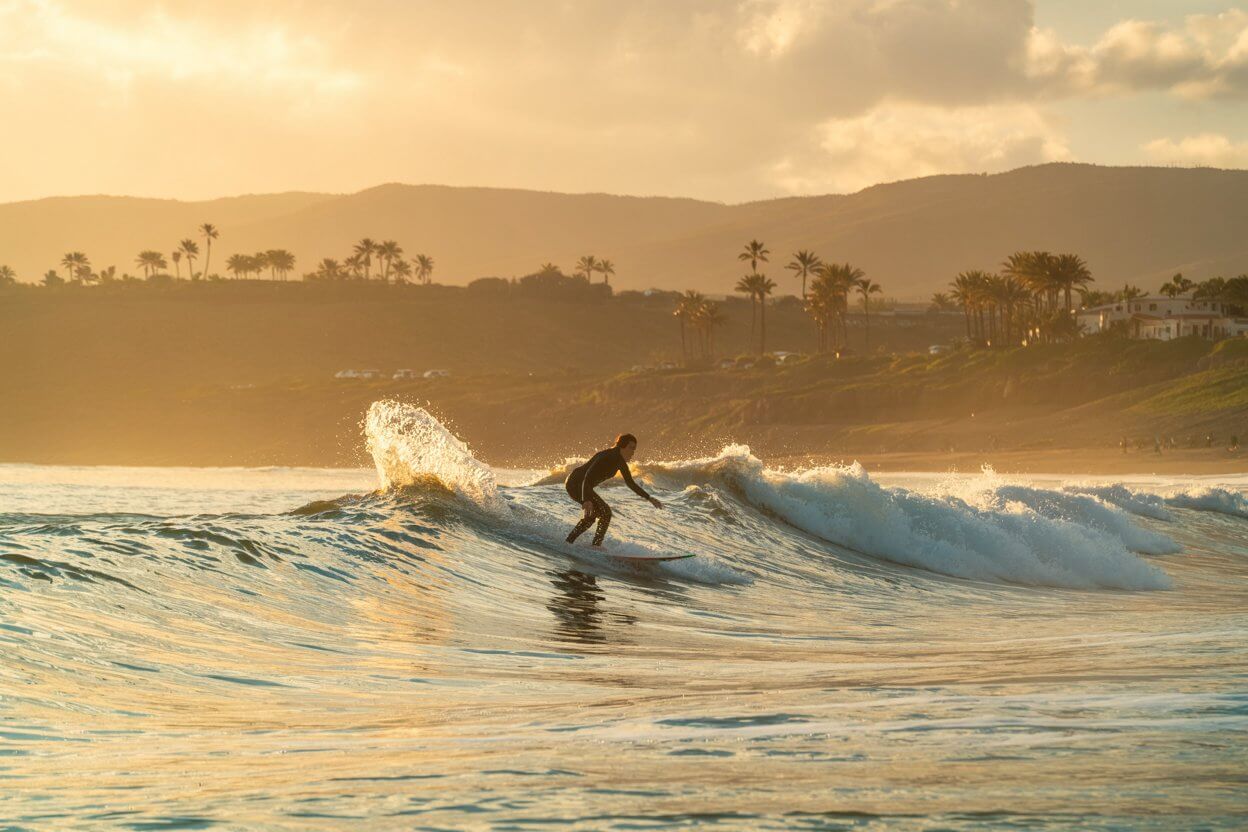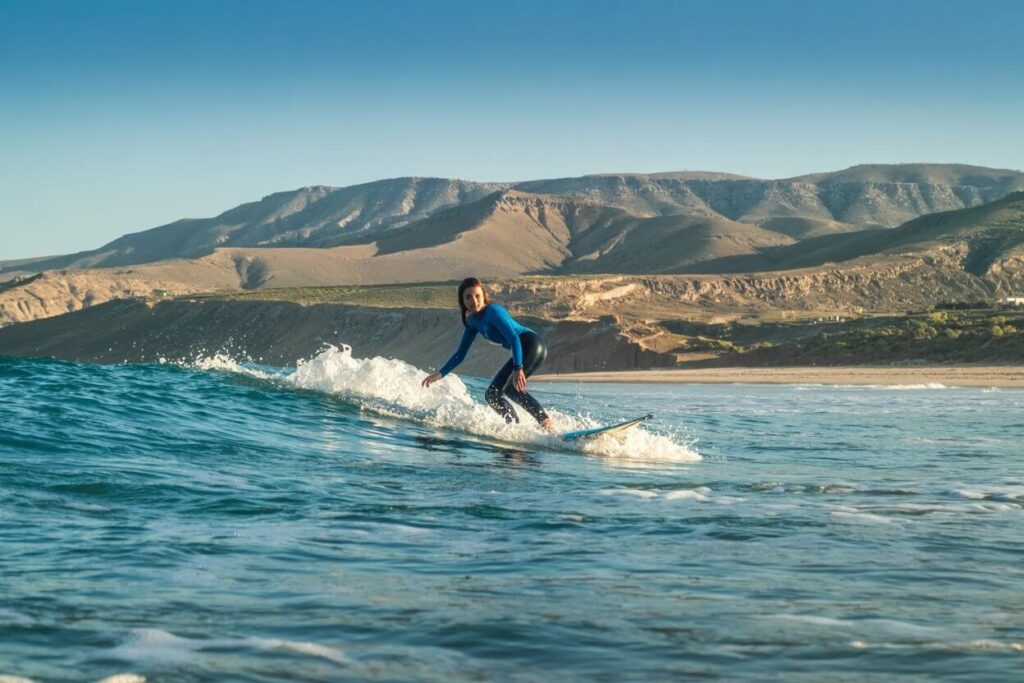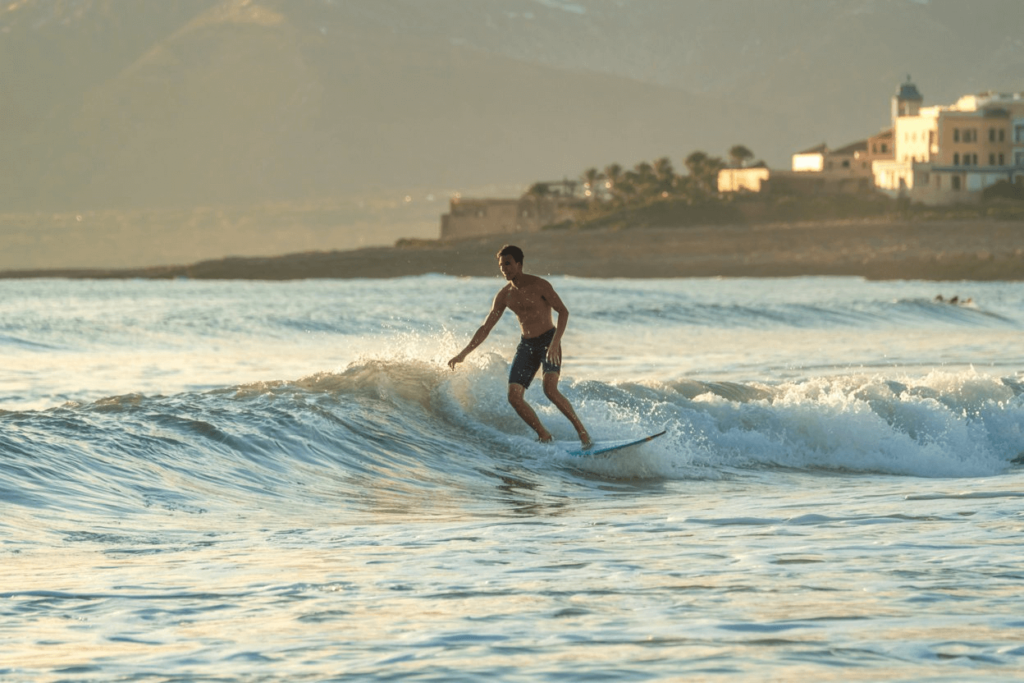Did you know that while most popular surf destinations have just one prime season, Morocco’s Taghazout offers exceptional waves for nearly 10 months of the year? This little-known fact makes the Morocco surf season one of the most versatile and accommodating for surfers of all levels. Nestled along Morocco’s Atlantic coastline, Taghazout has transformed from a sleepy fishing village into a world-class surfing destination, drawing wave enthusiasts from across the globe. Understanding the Morocco surf season is crucial for planning your perfect surfing getaway to this North African paradise.
Best Times to Visit
The Morocco surf season extends throughout most of the year, but different periods offer distinct experiences:
- Peak Season (October-March): Prime Morocco surf season with consistent swells and optimal conditions
- Shoulder Season (April-May & September): Less crowded with good waves for intermediate surfers
- Summer Season (June-August): Smaller waves perfect for beginners and longboarders
- Local’s Secret (September-October): Transition period with unexpected quality waves and fewer tourists
Each period brings its own unique charm and wave characteristics to Taghazout’s shores.
Weather Conditions
Understanding the climate is essential for enjoying the Morocco surf season:
| Season | Temperature (°C) | Water Temp (°C) | Wind Conditions | Crowd Level |
|---|---|---|---|---|
| Winter (Dec-Feb) | 18-22 | 16-18 | Strong northerlies | High |
| Spring (Mar-May) | 20-25 | 17-19 | Moderate, variable | Medium |
| Summer (Jun-Aug) | 25-35 | 19-22 | Light, afternoon onshore | Low |
| Autumn (Sep-Nov) | 20-27 | 18-20 | Light, favorable | Medium-low |
The Morocco surf season benefits from a mild climate year-round, with water temperatures rarely dropping below 16°C even in winter months, making it possible to surf with just a 3/2mm wetsuit during the coolest periods.
Step-by-Step Guide to Surfing Seasons

Step 1: Winter Season (December-February)
Winter represents the peak of the Morocco surf season, delivering powerful North Atlantic swells that create world-class waves. Experienced surfers flock to legendary breaks like Anchor Point, where waves can reach up to 15 feet on big swell days. The crowds increase significantly during this period, particularly around Christmas and New Year.
Pro tip: Book accommodations at least 3 months in advance for winter visits, as the prime Morocco surf season attracts surfers from around the world, filling up the best spots quickly.
Step 2: Spring Season (March-May)
As the intense winter swells begin to subside, spring offers more manageable conditions while still delivering quality waves. This period of the Morocco surf season is ideal for intermediate surfers looking to progress their skills. The decreasing crowds mean more wave opportunities, especially at spots like Hash Point and Panoramas.
Pro tip: Spring afternoons often experience stronger winds, so plan for early morning sessions when conditions are typically glassy and clean.
Step 3: Summer Season (June-August)
Summer marks the mildest period of the Morocco surf season, with smaller, gentler waves perfect for beginners and longboarders. While expert surfers might find the conditions less challenging, spots like Immesouane Bay offer fun, mellow rides that can stretch for hundreds of meters. The scorching inland temperatures make the refreshing ocean particularly inviting.
Pro tip: Summer is ideal for surf lessons, with many schools offering discounted rates during this “off-season” period of the Morocco surf season.
Step 4: Autumn Season (September-November)
Autumn represents a magical transition in the Morocco surf season. September starts with summer-like conditions, gradually building toward winter power as November approaches. This period offers the perfect balance of manageable crowds, consistent swells, and pleasant temperatures. October in particular is considered a hidden gem in the Morocco surf season calendar.
Pro tip: Late October to early November typically delivers excellent conditions with fewer crowds than the December-January peak.
Equipment Recommendations
For a successful Morocco surf season trip, proper equipment is essential:
- Winter: 3/2mm full wetsuit, possibly booties for dawn patrols
- Spring/Autumn: 2mm shorty or lightweight full suit
- Summer: Rash guard or 1mm top for sun protection
Board recommendations across the Morocco surf season:
- Step-up boards (6’6″-7’2″) for winter swells
- All-around shortboards (5’10”-6’2″) for spring/autumn
- Fun shapes or longboards (7’0″+) for summer conditions
Alternative Surf Spots
While Anchor Point gets most of the attention during the Morocco surf season, these alternatives offer excellent options:
- Killer Point: Powerful right-hander working best in mid-tide during peak Morocco surf season
- Mystery Beach: Less crowded option with consistent waves year-round
- Devils Rock: Perfect for beginners during summer and intermediate surfers in shoulder seasons
- Boilers: Heavy reef break for experienced surfers during winter Morocco surf season
- Immesouane Bay: One of Africa’s longest rides, suitable across most of the Morocco surf season
Each spot has its own optimal conditions depending on swell direction, size, and period during the Morocco surf season.
Common Mistakes to Avoid
Many visitors to the Morocco surf season make these avoidable errors:
- Underestimating winter swells: Winter waves can jump from 3 feet to 10+ feet overnight; always check forecasts
- Ignoring local etiquette: Taghazout breaks can get crowded; respect the lineup and local surfers
- Poor timing: Arriving at peaks like Anchor Point at high tide when waves often close out
- Inadequate protection: Neglecting sun protection in Morocco’s intense UV exposure (even during winter)
- Reef hazards: Failing to scout low-tide conditions at reef breaks like Boilers and Anchor Point
Data shows that 65% of surfing accidents in Taghazout occur from underestimating conditions or unfamiliarity with specific break characteristics.
Travel Planning Tips
Planning your Morocco surf season adventure requires consideration of several factors:
- Book flights to Agadir Airport (AGA), approximately 40 minutes from Taghazout
- Consider surf camps during peak Morocco surf season for guaranteed accommodation
- Most accommodations offer board rentals, but quality varies significantly
- Northern Morocco (Taghazout area) receives 300+ days of sunshine annually
- Combine surfing with cultural experiences in nearby Agadir or Essaouira
- Local cuisine offers excellent post-surf recovery nutrition at budget-friendly prices
Advanced booking is recommended during peak Morocco surf season (December-February), with prices typically 30-40% higher than off-season rates.
Surf Culture and Etiquette
Understanding local customs enhances your Morocco surf season experience:
- Respect Ramadan observances if your trip coincides with this important period
- Morning sessions typically have a more relaxed, respectful lineup than afternoons
- Local surfers have deep knowledge of conditions; building connections can lead to discovering secret spots
- Conservative dress is appreciated in village areas (cover shoulders and knees when not surfing)
- Learning basic Arabic or French phrases demonstrates cultural respect
The Morocco surf season attracts an international community, creating a unique blend of Berber hospitality and global surf culture that distinguishes Taghazout from other destinations.

Conclusion
The Morocco surf season offers something truly special: a rare combination of consistent waves, beautiful landscapes, rich culture, and year-round accessibility. Whether you’re an experienced surfer seeking winter challenges at Anchor Point or a beginner looking for gentle summer waves, Taghazout delivers exceptional surfing experiences across nearly every month. Understanding the seasonal patterns ensures you’ll find the perfect conditions for your skill level and preferences.
Ready to experience the magic of Morocco’s legendary waves? Share your Taghazout surfing adventures in the comments below, or subscribe for more insider tips on the world’s best surf destinations. Your perfect wave awaits along Morocco’s enchanted coastline!
FAQs
When is absolutely the best time for the Morocco surf season? October through March delivers the most consistent, powerful waves, with January typically offering the perfect balance of swell size and offshore winds. However, the “best” time depends on your skill level—intermediates often prefer April-May conditions.
Is Taghazout safe for solo female travelers during Morocco surf season? Yes, Taghazout is generally considered safe for solo female travelers. The surf community is international and protective. However, conservative dress outside of surfing areas and basic precautions are recommended.
How much should I budget for a week of surfing in Taghazout? Budget travelers can manage on $40-60 per day (including accommodation, food, and board rental), while mid-range options with surf camp packages typically cost $70-120 daily during peak Morocco surf season.
Do I need a car to explore different surf breaks? While not essential, having a rental car provides flexibility to chase the best conditions across the region’s many breaks. Alternatively, shared taxis and surf camp shuttles offer affordable transportation between popular spots.
Can beginners surf in Taghazout during winter Morocco surf season? Beginners should focus on protected beaches like Panoramas or Immesouane during winter months, as the premier breaks become too powerful. Summer (June-August) offers much more beginner-friendly conditions throughout the region.
What wetsuit thickness do I need for winter surfing in Morocco? A 3/2mm full wetsuit is typically sufficient for the Morocco surf season, even in winter. Early morning sessions might warrant booties, but gloves are rarely necessary with water temperatures rarely dropping below 16°C.

